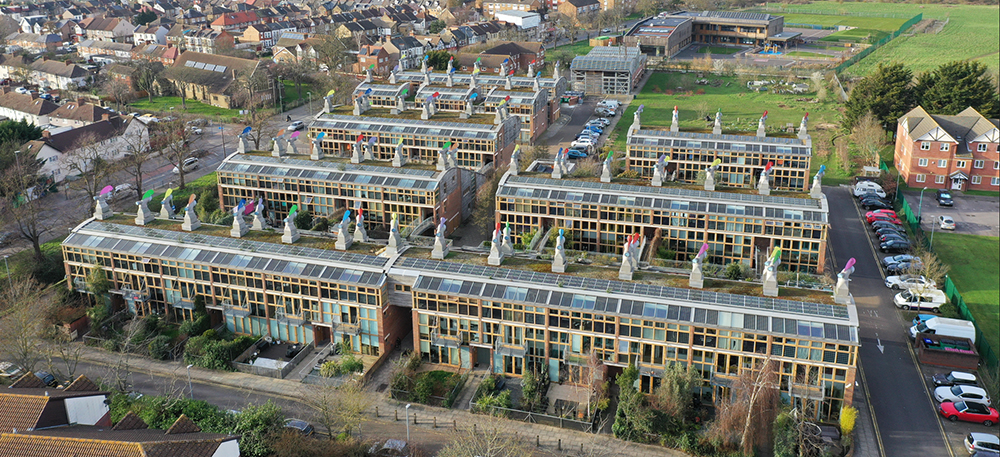Sunspace
Sunspace is a relatively recent term which describes something similar to a winter garden, but constructed for reasons relating more to passive or solar design principles and building performance than for entertainment or horticulture.
A sunspace is a south-facing glazed area, similar to a winter garden, but not part of the thermal line or fabric envelope of the building. The space acts as a thermal buffer-zone in the winter, improving the thermal performance of adjoining walls and preheating colder outside air during the day before it enters the main building.
On milder summer days it acts as a warmer sunroom, whilst during peak summer daytime heat temperatures may become much higher, with some potential for heat exchange (sun as pre heating hot water). The space itself should be balanced with suitable extracts (potentially via heat exchangers ) or high level opening vents.
One example where extensive use of south-facing fully height glazed sunspaces contributed to the efficient performance of a building was in the Eco-development Beddington Zero (fossil) Energy Development known as Bedzed, located in South London. The sunspaces provide buffer zones to the external wall space and contribute to the low heating requirements for the buildings. The spaces had high level vents which were regrettably value engineered and this led to over heating issues in 2022. In discussion of the benefits of sunspaces, the architect said they 'add about 7.5% to the build cost, increase the floor area by 15% and can be occupied for 80% of the year without needing any extra heating'.
[edit] Related articles on Designing Buildings
Featured articles and news
RTPI leader to become new CIOB Chief Executive Officer
Dr Victoria Hills MRTPI, FICE to take over after Caroline Gumble’s departure.
Social and affordable housing, a long term plan for delivery
The “Delivering a Decade of Renewal for Social and Affordable Housing” strategy sets out future path.
A change to adoptive architecture
Effects of global weather warming on architectural detailing, material choice and human interaction.
The proposed publicly owned and backed subsidiary of Homes England, to facilitate new homes.
How big is the problem and what can we do to mitigate the effects?
Overheating guidance and tools for building designers
A number of cool guides to help with the heat.
The UK's Modern Industrial Strategy: A 10 year plan
Previous consultation criticism, current key elements and general support with some persisting reservations.
Building Safety Regulator reforms
New roles, new staff and a new fast track service pave the way for a single construction regulator.
Architectural Technologist CPDs and Communications
CIAT CPD… and how you can do it!
Cooling centres and cool spaces
Managing extreme heat in cities by directing the public to places for heat stress relief and water sources.
Winter gardens: A brief history and warm variations
Extending the season with glass in different forms and terms.
Restoring Great Yarmouth's Winter Gardens
Transforming one of the least sustainable constructions imaginable.
Construction Skills Mission Board launch sector drive
Newly formed government and industry collaboration set strategy for recruiting an additional 100,000 construction workers a year.
New Architects Code comes into effect in September 2025
ARB Architects Code of Conduct and Practice available with ongoing consultation regarding guidance.
Welsh Skills Body (Medr) launches ambitious plan
The new skills body brings together funding and regulation of tertiary education and research for the devolved nation.
Paul Gandy FCIOB announced as next CIOB President
Former Tilbury Douglas CEO takes helm.
UK Infrastructure: A 10 Year Strategy. In brief with reactions
With the National Infrastructure and Service Transformation Authority (NISTA).
























Comments
[edit] To make a comment about this article, or to suggest changes, click 'Add a comment' above. Separate your comments from any existing comments by inserting a horizontal line.